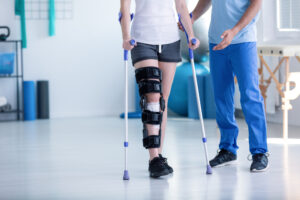 Sports injuries, the unwelcome companions of athletes and fitness enthusiasts, are physical mishaps during sports or exercise activities. These can range from minor, such as bruises, to more severe, like fractures or tears. Particularly vulnerable are our joints—knees, ankles, and shoulders—that bear the brunt of physical exertions and are often at the epicenter of these injuries.
Sports injuries, the unwelcome companions of athletes and fitness enthusiasts, are physical mishaps during sports or exercise activities. These can range from minor, such as bruises, to more severe, like fractures or tears. Particularly vulnerable are our joints—knees, ankles, and shoulders—that bear the brunt of physical exertions and are often at the epicenter of these injuries.
Understanding joint health is paramount, not just for athletes but for everyone. Joints are crucial for mobility, daily life, and overall well-being. When healthy, they contribute significantly to peak athletic performance. However, damage from sports injuries can have lasting ramifications. Here’s a detailed look into how sports injuries can influence long-term joint health, impacting an individual’s quality of life.
Types Of Sports Injuries Affecting Joints
 Joint injuries are common in sports and can range from mild to severe. A sudden impact, overuse, or a combination can cause them. Some of the most common types of sports injuries affecting joints include:
Joint injuries are common in sports and can range from mild to severe. A sudden impact, overuse, or a combination can cause them. Some of the most common types of sports injuries affecting joints include:
- Sprains And Strains
Sprains and strains are the most common types of sports injuries. A sprain is a stretching or tearing of a ligament, which is a band of tissue that connects bones. A strain is a stretching or tearing of a muscle or tendon, a band of tissue connecting a muscle to a bone.
Sprains and strains can occur in any joint but are most common in the ankles, knees, and shoulders. A sudden twisting motion can be caused by a direct blow to the joint or overuse.
A sprain or strain symptoms include pain, swelling, bruising, and stiffness. In mild cases, the symptoms may go away within a few days. However, the symptoms may last for weeks or even months in more severe cases. You can go here to learn more about how specialists can help you in treating sprains and strains
- Dislocations
A dislocation occurs when the bones in a joint are no longer in their normal position. This can happen when a joint is forcefully bent or twisted. Dislocations are most common in the shoulders, fingers, and knees.
The symptoms of dislocation include severe pain, swelling, and joint deformity. The joint may also be unable to move.
Dislocations require immediate medical attention. The bones in the joint must be put back in their proper position, usually done under anesthesia. After the bones are relocated, the joint will be immobilized with a cast or brace for several weeks.
- Fractures
A fracture is an injury caused when a bone breaks due to a sudden impact, a fall, or a twisting motion. Fractures can occur in the bones of the feet, ankles, wrists, and arms.
The symptoms include swelling, pain, and deformity of the bone. The bone may also be visible through the skin.
Fractures require medical attention. The bone must be set (aligned) and immobilized with a cast or brace. In some cases, surgery may be necessary to repair the fracture.
- Ligament And Tendon Injuries
Ligaments and tendons are the tissues that connect bones and muscles to bones. Ligament injuries can occur when a joint is forcefully bent or twisted. Tendon injuries can occur when a muscle is forcefully contracted.
Ligament and tendon injuries can cause pain, swelling, and stiffness. The injury may cause a popping or tearing sensation in some cases. Ligament and tendon injuries typically heal on their own within a few weeks. However, in some cases, surgery may be necessary to repair the injury.
- Overuse Injuries
Overuse injuries occur when a joint is subjected to repetitive stress. This can happen with activities such as running, swimming, and dancing. Overuse injuries can cause pain, swelling, and inflammation. In some cases, the injury may also cause a loss of range of motion.
Overuse injuries typically heal with rest and physical therapy. However, in some cases, surgery may be necessary to repair the injury. It is important to see a doctor if you think you have a sports injury. The doctor can diagnose the injury and recommend the best course of treatment.
Consequences Of Sports Injuries On Joints
Sports injuries can lead to several immediate and long-term consequences. These effects are not limited to physical discomfort but often extend to emotional and psychological aspects. They include:
- Pain And Swelling
The immediate aftermath of a sports-related joint injury often manifests in pain and swelling. This reaction is the body’s signaling damage and initiating the healing process. While pain is a natural and instantaneous alert system, swelling immobilizes the injured area.
Pain and swelling can vary in intensity, depending on the severity of the injury. A minor sprain may cause discomfort and slight swelling, whereas a severe injury like a torn ligament can lead to excruciating pain and significant inflammation. Prompt medical attention is vital in both cases.
Managing the pain and swelling requires careful treatment, including rest, ice, compression, and elevation (commonly known as the RICE method). Medical intervention, including medications or surgery, might be necessary in more severe cases.
2. Limited Range Of Motion
Joint injuries often lead to a limited range of motion. When a joint is injured, the affected area may become stiff, making movement difficult and sometimes impossible. This limitation can be temporary or become a chronic issue if not treated properly.
A restricted range of motion can hinder daily activities and affect the overall quality of life. Simple tasks like bending, lifting, or walking can become challenging and frustrating. This limitation can also mean a temporary or permanent halt to sports activities for athletes.
Physical therapy and rehabilitation are often essential in restoring the range of motion. Exercise, stretching, and proper guidance from healthcare professionals can help regain mobility and function over time.
3. Chronic Pain And Discomfort
Chronic pain and discomfort are long-term consequences that may arise from sports injuries. If an injury is not treated effectively, the pain may persist long after the incident, leading to discomfort and frustration.
Chronic pain affects not only physical health but also mental well-being. Continuous pain can lead to stress, anxiety, and even depression. It impacts daily life, social activities, and overall happiness.
Proactive management, including medical care, regular exercise, and psychological support, can help alleviate chronic pain. Understanding the root cause and tailoring treatment accordingly is essential for relief and improvement.
4. Arthritis And Other Degenerative Conditions
Sports injuries can lead to arthritis and other degenerative conditions over time. An injured joint may weaken and become more susceptible to wear and tear, accelerating the natural aging process of the joint.
Arthritis can cause stiffness, pain, and swelling, significantly impacting the ability to move and perform daily tasks. It can become a debilitating condition if left untreated, leading to severe limitations and dependence on others.
Early intervention, lifestyle modifications, and proper medical care can slow the progression of arthritis and other degenerative conditions. A multidisciplinary approach involving healthcare providers, physical therapists, and nutritionists may be beneficial.
5. Long-term Disability
The consequences of sports injuries on joints can lead to long-term disability. This disability may manifest as persistent pain, limited movement, and dependence on assistive devices or other people for basic activities.
Such disabilities affect the individual’s physical abilities, self-esteem, and independence. The inability to perform once effortless tasks can lead to helplessness and frustration.
Careful management, rehabilitation, and support can help mitigate long-term disabilities. Adapting to new ways of performing tasks, embracing assistive devices, and seeking emotional support can foster resilience and improve quality of life.
6. Psychological Effects
The psychological effects of joint injuries can be as profound as the physical ones. The loss of mobility and independence can lead to feelings of despair, anxiety, and depression. These emotions may affect the individual’s relationships, work, and overall enjoyment of life.
For athletes, an injury can be career-altering or even career-ending. The fear of re-injury might persist, affecting performance and confidence. Professional counseling may be necessary to help cope with these mental and emotional challenges.
Understanding and addressing the psychological effects of sports injuries is vital for complete recovery. Integrating mental health support and physical rehabilitation can provide a holistic approach to healing, paving the way for a more successful recovery and return to normal life.
Prevention And Management
The battle against sports injuries affecting joint health doesn’t end with treatment; it extends to prevention and ongoing management. Here are some prevention measures:
- Proper Training And Technique
Proper training and technique are the cornerstones of preventing sports injuries, especially those affecting the joints. Athletes and fitness enthusiasts must prioritize learning the correct form and movement patterns to minimize strain on vulnerable areas. Proper warm-ups and cool-downs are also integral to preparing the muscles and joints for physical activities.
Coaches and trainers are pivotal in imparting correct training methods and techniques. Their expert guidance ensures individuals engage in exercises matching their abilities and goals. They can also identify potential issues early, averting the progression into serious injuries.
Lastly, cross-training, where different forms of exercises are combined, helps balance the body’s muscle groups. This can lead to better joint stability, reducing the risk of overuse injuries. Proper training and technique, therefore, create a foundation for healthy joint function.
2. Protective Equipment
Protective equipment is a barrier against injuries, cushioning the impact or preventing extreme movements that might harm the joints. This includes things like knee pads, helmets, or specially designed footwear. Appropriate equipment is not confined to professional athletes; recreational players and even fitness beginners can benefit greatly from this equipment.
However, more than merely using protective equipment is required; it must fit correctly and be used appropriately for the specific activity. Ill-fitted or misused gear might fail to protect and can sometimes contribute to injuries. Regular inspection for wear and tear and replacing equipment as needed ensures maximum protection.
Education on how to use protective equipment, along with making it accessible, can create a safer environment for sports and exercise. It sends a message that safety is a priority, encouraging a culture of prevention rather than merely dealing with injuries after they occur.
3. Early Diagnosis And Treatment
Early diagnosis and treatment of sports injuries, particularly those affecting the joints, can mean a swift recovery and prevent long-term complications. Acknowledging pain or discomfort, rather than dismissing it, sets the stage for prompt medical attention. Trained medical professionals can then take necessary actions to treat the injury.
Diagnostic tools like X-rays, MRIs, or ultrasound provide insights into the extent and nature of the injury. They guide medical professionals in determining the best course of treatment. Early intervention might include rest, medication, or specific exercises to promote healing.
Treatment plans tailored to the individual’s needs can prevent minor issues from developing into chronic conditions. Following medical advice and engaging in rehabilitation as directed accelerates recovery, preserving joint function and overall health.
4. Physical Therapy And Rehabilitation Protocols
Physical therapy and rehabilitation are essential in recovering from joint injuries. These interventions restore function, improve mobility, and relieve pain. They often begin with a comprehensive assessment to determine the specific needs and goals of the patient.
Therapists then create personalized treatment plans, including exercises, manual therapy, or modalities like heat or cold. Consistency in following these plans is crucial, as healing is often a gradual process. A certified therapist can monitor progress and make necessary adjustments.
Moreover, education about the home exercises or lifestyle modifications further supports the healing process. Empowering individuals to participate in their recovery actively fosters a positive attitude toward health. Physical therapy and rehabilitation, therefore, are not merely treatments but partnerships in healing.
5. Psychological Support And Counseling
The journey toward recovery from a joint injury is physical and psychological. Facing limitations or adapting to new routines can be challenging. Psychological support and counseling can provide mental and emotional assistance during this time.
Counseling offers a safe space to express frustrations, fears, or concerns. Strategies to cope with pain, anxiety, or depression can be explored, fostering resilience and positive thinking. It recognizes that mental health is an integral part of overall well-being.
Support groups or therapy sessions with fellow athletes who have undergone similar experiences may be beneficial in some cases. Shared experiences can create a sense of camaraderie and provide practical insights. Therefore, psychological support is a valuable component of comprehensive care, helping individuals recover from an injury and thrive beyond it.
Conclusion
Understanding the impact of sports injuries on long-term joint health is essential for athletes and the general population. From the types of damages to their immediate effects, long-term consequences, and crucial measures for prevention and management, this comprehensive guide serves as a resource.
Awareness, education, and collaboration among coaches, healthcare providers, and policymakers significantly mitigate the risk of injuries. Adopting a proactive approach toward joint health can promote a healthier, more active society. This ensures that sports and physical activities remain sources of joy and fulfillment rather than pain and disability.


